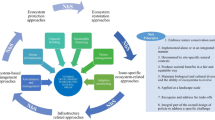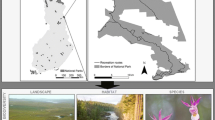Abstract
The Philippines is Southeast Asia’s second biggest archipelago. From coral reefs to tropical, forested mountains, the country is a biodiversity hotspot under threat from the rapid rate of environmental degradation. The establishment and expansion of protected areas (PAs) has been one of the major biodiversity conservation counterstrategies. The National Integrated Protected Areas Systems (NIPAS) Act of 1992 provides the legal framework for PA’s designation and management. NIPAS legislates for 11 categories of PAs that collectively cover about 15% of the country’s total land mass and 1% of marine territory. PAs established under NIPAS are managed by multi-sectoral PA Management Boards (PAMB) representing various stakeholders, but effective administration faces perennial governance and funding challenges. If NIPAS epitomized efforts to conserve biodiversity, the Indigenous People’s Rights Act (IPRA) of 1997 legitimized the involvement of indigenous people in PA management, including sensitive issues of ancestral domain. Meanwhile nature-based tourism (NBT) has increased in PAs such as Mount Apo. This chapter investigated Apo climber fees collected using a total economic value framework to show how NBT activities could provide additional funds to make PA management more effective and incentivize a wider range of stakeholders in the PAMB.
Access this chapter
Tax calculation will be finalised at checkout
Purchases are for personal use only
Similar content being viewed by others
References
Apollo, M. (2017). The good, the bad and the ugly–three approaches to management of human waste in a high-mountain environment. International Journal of Environmental Studies, 74(1), 129–158.
Apollo, M., Mostowska, J., Maciuk, K., Wengel, Y., Jones, T. E., & Cheer, J. M. (2020). Peak-bagging and cartographic misrepresentations: A call to correction. Current Issues in Tourism. https://doi.org/10.1080/13683500.2020.1812541
Balmford, A., Aaron, B., Cooper, P., Costanza, R., Farber, S., Green, R. E., Jenkins, M., Jefferiss, P., Jessamy, V., Madden, J., Munro, K., Myers, N., Naeem, S., Paavola, J., Rayment, M., Rosendo, S., Roughgarden, J., Trumper, K., & Turner, R. K. (2002). Economic reasons for conserving wild nature. Science, 297(5583), 950–953.
Carandang, A. P. (2012). Assessment of the contribution of forestry to poverty alleviation in the Philippines. In FAO, Making forestry work for the poor: Assessment of the role of forestry on poverty alleviation in Asia and the Pacific (pp. 267–292). Regional Office for Asia and the Pacific, FAO.
Chase, L. C., Lee, D. R., Schulze, W. D., & Anderson, D. J. (1998). Ecotourism demand and differential pricing of national park access in Costa Rica. Land Economics, 74(4), 466–482.
Clawson, M., & Knetsch, J. L. (1966). Economics of outdoor recreation. Johns Hopkins University Press.
Congress of the Philippines. (1997). Indigenous Peoples Right Act (Republic Act 8731).
Corpuz, J. D., & Jones, T. E. (2017). Common goals, different roles in devolved management: A review of conservation policies in Palawan Protected Areas. Governance Policy Research Network Bulletin, 12, 69–97.
Cortina-Villar, S., Plascencia-Vargas, H., Vaca, R., Schroth, G., Zepeda, Y., Soto-Pinto, L., & Nahed-Toral, J. (2012). Resolving the conflict between ecosystem protection and land use in protected areas of the Sierra Madre de Chiapas Mexico. Environmental Management, 49(3), 649–662.
Dames & Moore Inc. (1994). Study on the biodiversity and cost benefit analysis of the Mt. Apo geothermal project. PNOC-Energy Development Corporation.
DENR. (2008). DENR Administrative Order No. 2008-26: Revised implementing rules and regulations of Republic Act No. 7586 or the National Integrated Protected Areas System (NIPAS) Act of 1992. Department of Environment and Natural Resources, Quezon City, Philippines.
DENR-PAWB. (2009). Assessing progress towards the 2010 biodiversity target: The 4th national report to the Convention on Biological Diversity. Protected Areas and Wildlife Bureau, Department of Environment and Natural Resources, Quezon City, Philippines.
DENR-PAWB. (2012). Communities in nature: State of protected areas management in the Philippines. Protected Areas and Wildlife Bureau, Department of Environment and Natural Resources, Quezon City, Philippines.
DENR-PAWB. (2013). Technical bulletin number 2013-01: List of protected areas under the National Integrated Protected Areas System (NIPAS). Protected Areas and Wildlife Bureau, Department of Environment and Natural Resources, Quezon City, Philippines.
DENR-PAWB & GIZ. (2011). An in-depth review of the NIPAS Law and related statutes on the establishment and management of protected areas in the Philippines: A final report. Protected Areas and WIldlife Bureau, Department of Environment and Natural Resources and the Deutsche Gesellschaft für Internationale Zusammenarbeit (GIZ) GmbH, Manila, Philippines. http://www.enrdph.org/docfiles/20130228_NIPAS%20Review_FINAL_[web].pdf.
DENR-PAWCZMS. (2013). The Mount Apo Natural Park updated general management plan 2013–2033. DENR-PAWCZMS 11, Davao City, Philippines.
Dressler, W. H., Kull, C. A., & Meredith, T. C. (2006). The politics of decentralizing national parks management in the Philippines. Political Geography, 25, 789–816.
FAO. (2010). Global forest resources assessment 2010 country report: Philippines. FRA2010/164. Food and Agriculture Organization of the United Nations, Rome, Italy.
Forest Resources Assessment Programme (FAO). (2015). Global forest resources assessment 2015. http://fao.org/3/a-i4808e.pdf.
Gomez, A. L. V. (2015). Identification and valuation of ecosystem services in the Mount Apo Natural Park, the Philippines, as a basis for exploring the potential of ‘payments for environmental services’ for protected area management (Unpublished PhD thesis). Charles Darwin University, Australia.
Greiner, R., & Rolfe, J. (2004). Estimating consumer surplus and elasticity of demand of tourist visitation to a region in North Queensland using contingent valuation. Tourism Economics, 10(3), 317–328.
Jin, J., Indab, A., Nabangchang, O., Thuy, T. D., Harder, D., & Subade, R. F. (2010). Valuing marine turtle conservation: A cross-country study in Asian cities. Ecological Economics, 69(10), 2020–2026.
Mallari, N. A. D., Tabaranza, B. R., & Crosby, M. J. (2001). Key conservation sites in the Philippines: A Haribon Foundation and BirdLife International directory of important bird areas. Bookmark.
Mallari, N. A. D., Collar, N. J., McGowan, P. J. K., & Marsden, S. J. (2016). Philippine protected areas are not meeting the biodiversity coverage and management effectiveness requirements of Aichi Target 11. Ambio, 45, 313–322.
La Viña, A. G. M., Kho, J. L., & Caleda, M. (2010). Legal framework for protected areas: Philippines. IUCN-Environmental Policy and Law Papers, 81. https://www.iucn.org/downloads/philippines.pdf.
Ong, P. S., Afuang, L. E., & Rosell-Ambal, R. G. (Eds.). (2002). Philippine biodiversity conservation priorities: A second iteration of the national biodiversity strategy and action plan. DENR-PAWB, CI Philippines, UP-CIDS & FPE, Quezon City, Philippines.
Philippine Statistics Authority (PSA). (2015). Census of Population, computed from 2010–2015 growth rate. www.psa.gov.ph.
Pulhin, J. M., & Inoue, M. (2008). Dynamics of devolution process in the management of the Philippine forests. International Journal of Social Forestry, 1(1), 1–26.
Rodríguez, J. P., Beard, J. T. D., Bennett, E. M., Cumming, G. S., Cork, S. J., Agard, J., Dobson, A. P., & Peterson, G. D. (2006). Trade-offs across space, time, and ecosystem services. Ecology and Society, 11(1). http://www.ecologyandsociety.org/vol11/iss1/art28/.
Schroeder, H. W., & Louviere, J. (1999). Stated choice models for predicting the impact of user fees at public recreation sites. Journal of Leisure Research, 31(3), 300–324.
Senga, R. G. (2001). Establishing protected areas in the Philippines: Emerging trends, challenges and prospects. The George Wright FORUM, 18(1), 56–65.
Severino, H. (2000). The role of local stakeholders in forest protection. In P. Utting (Ed.), Forest policy and politics in the Philippines: The dynamics of participatory conservation (pp. 84–116). Ateneo de Manila University Press.
Shackleton, S., Cambell, B., Wollenberg, E., & Edmunds, B. (2002). Devolution and community-based natural resource management: Creating space for local people to participate and benefit? Natural Resource Perspectives, 76, 1–6.
Simon, S. (2013). Of boars and men: Indigenous knowledge and co-management in Taiwan. Human Organization, 72(3), 220–229.
Stoeckl, N., Hicks, C. C., Mills, M., Fabricius, K., Esparon, M., Kroon, F., Kaur, K., & Costanza, R. (2011). The economic value of ecosystem services in the Great Barrier Reef: Our state of knowledge. Annals of the New York Academy of Sciences, 1219(1), 113–133.
Subade, R. F. (2005). Valuing biodiversity conservation in a world heritage site: Citizens’ non-use values for Tubbataha Reefs National Marine Park, Philippines. Research Report No. 2005-RR4, Economy and Environment Program for Southeast Asia, Singapore. http://www.eepsea.net/pub/rr/11201034921RodelRR4.pdf.
United Nations Development Program (UNDP). (2012). Communities in nature: State of protected areas management in the Philippines (48 pp.). PAs & Wildlife Bureau.
UNESCO World Heritage Centre (WHC). (2011). Tentative lists: Mount Apo Natural Park. https://web.archive.org/web/20110311220211/https://whc.unesco.org/en/tentativelists/5485/.
WCED (1987). Our common future (G. H. Brundtland, Ed.). The World Commission on Environment and Development. Oxford University Press.
Author information
Authors and Affiliations
Corresponding author
Editor information
Editors and Affiliations
Rights and permissions
Copyright information
© 2021 The Author(s), under exclusive license to Springer Nature Switzerland AG
About this chapter
Cite this chapter
Gomez, A.L.V., Jones, T.E. (2021). Protected Areas and Nature-Based Tourism in the Philippines: Paying to Climb Mount Apo Natural Park. In: Jones, T.E., Bui, H.T., Apollo, M. (eds) Nature-Based Tourism in Asia’s Mountainous Protected Areas. Geographies of Tourism and Global Change. Springer, Cham. https://doi.org/10.1007/978-3-030-76833-1_8
Download citation
DOI: https://doi.org/10.1007/978-3-030-76833-1_8
Published:
Publisher Name: Springer, Cham
Print ISBN: 978-3-030-76832-4
Online ISBN: 978-3-030-76833-1
eBook Packages: Social SciencesSocial Sciences (R0)




